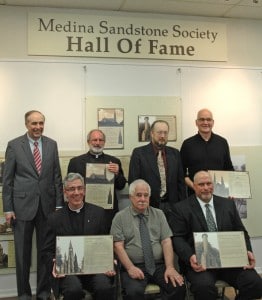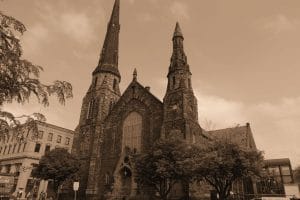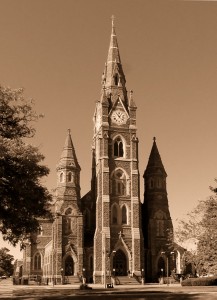2014 Medina Sandstone Hall of Fame
Download printable brochure HOF Tri-fold brochure 2014
Nominations and Inductees
The following were new nominations for the 2014 Hall of Fame:
-
Presbyterian Church – Albion 1874
-
Ashbury Church – Buffalo 1875
-
Olmsted Traffic Circles – Buffalo 1876
-
Buffalo Crematory – Buffalo 1885
-
Sonnenberg – Canandaigua 1887
-
Prendergast Library – Jamestown 1891
-
St. Peters – Erie PA 1873-1893
-
St. Lukes – Jamestown 1894
-
former St. Rocco’s church – Hulberton 1906
-
Robin Hill (private residence) – Lyndonville 1952
From this list of nominees and the 10 from 2013, four new buildings were inducted into the Hall of Fame.
(Download 2014 brochure)
Mt. Albion
Soldiers’ and Sailors’ Monument
Albion, NY
Rising from the top of the highest point in Mt. Albion Cemetery, this 58 foot high tower memorializes the soldiers from Orleans County who lost their lives in the Civil War.
The monument was built of red Medina sandstone from nearby quarries. It was constructed in stages as local money for the project could be raised.
The monument was completed in time for a dedication ceremony on the 100th anniversary of the country, July 4, 1876.
In more recent times the tower fell into disrepair. In the early 1970’s the tower was considered unsafe and there were suggestions that it should be torn down. Local high school students began a “Save the Tower” campaign which raised enough money to repair masonry joints and the interior steel, spiral staircase. The tower was rededicated on July 4, 1976.
Today the tower is open to the public. Those who make the climb to the top are rewarded with a spectacular view of distant points throughout Orleans County.
The Medina Sandstone Society is proud to induct this outstanding example of Medina sandstone construction into the Medina Sandstone Hall of Fame class of 2014.
Saint Louis R.C. Church
Buffalo, NY
In 1832, at the corner of Main and Edward Street, a simple hand hewn log building became the first Roman Catholic Church in Buffalo. In 1843 this was replaced by a stone and brick church and finally, on the same site, from 1886-1889 the magnificent St. Louis Church (“Mother Church of the Diocese of Buffalo”) was constructed.
Designed by architect William Schikel of New York City, this Gothic Revival church is built of red Medina sandstone. One of the largest ecclesiastical buildings in Buffalo, the church can seat nearly 2,000 people.
Heavily influenced by German design features, the distinctive front facade consists of two 128 foot side towers and the magnificent 245 foot center steeple and open-work spire. Perhaps the church’s most distinctive feature, this center spire, similar to the spires on several German churches including Cologne Cathedral, is the tallest open-work spire ever built completely of stone in the United States. It is also believed to be the only remaining open-work or pierced spire in the U.S.
A major restoration project was undertaken on the 175th anniversary in 2002-2003. This included slate roof repairs, tower restoration, repointing and cleaning exterior stone and much interior restoration. With such continued support from the parishioners, the St. Louis Church will remain a striking Buffalo landmark for generations to come.
The Medina Sandstone Society is proud to induct this outstanding example of Medina sandstone construction into the Medina Sandstone Hall of Fame class of 2014.
“Babeville”
(former Delaware Asbury Methodist Church)
Buffalo, NY
Designed by the Buffalo-based architect John H. Selkirk, the Gothic Revival structure was constructed between 1871 and 1876. This was Selkirk’s most ambitious project of many in the Buffalo area.
The building, completed at a cost of $130,000, was constructed of brown Medina sandstone with Connecticut stone trim. The northern steeple on the asymmetrical front towers to over 200 feet in height.
The combined congregations of the Delaware and the former Asbury church worshiped in this structure until about 1980. Other congregations occupied the building for the next 10 years, but then it sat empty, its structure deteriorating and its interior vandalized. The City of Buffalo took ownership of the building, but by 1995 stones falling from the structure caused adjacent sidewalks to be closed and the church was slated for demolition.
However an outcry from the community led to the formation of the “Citizens to Save the Asbury Church”. Legal action stopped the plans for demolition and the group began to raise funds for emergency repairs. In 1999 musician Ani DiFranco and manager Scott Fisher negotiated a plan for purchase and restoration which began a five year reconstruction process to create a center for music and art in Buffalo’s downtown.
The development of “Babeville” saved this beautiful, historic building and contributed to a new appreciation of Buffalo’s heritage which today plays a major role in the revitalization of the city.
The Medina Sandstone Society is proud to induct this outstanding example of Medina sandstone construction into the Medina Sandstone Hall of Fame class of 2014.
St. Peter Cathedral
Erie, PA
The Diocese of Erie initiated plans for building St. Peter Cathedral in 1873. Noted 19th-century ecclesiastical architect Patrick Charles Keeley of Brooklyn designed this Gothic revival church which, after many years of construction and fundraising, was completed in 1893. The 1884 History of Erie County stated that St. Peter’s “…when finished will be one of the grandest – if not the grandest – and most imposing church edifices in the lake country.”
Constructed primarily of red Medina sandstone with white trim of more locally quarried stone, the cathedral is 220 feet long and 130 feet at its widest point. The front of the church is formed from three massive towers. The center bell tower stands 265 feet high and on either side are Norman style towers 150 feet in height. In 1903 twelve bells manufactured in Troy, NY weighing a total of 14 tons and a four faced clock manufactured by the Howard Clock Company in Boston were installed in the center tower.
The History of Erie County stated “Protestants, alike with the Catholics of Erie, will look upon this edifice with pride and admiration, and it will stand as a living monument to the zeal and devotion…of the diocese of Erie, through whose untiring efforts the structure has been reared.”
The Medina Sandstone Society is proud to induct this outstanding example of Medina sandstone construction into the Medina Sandstone Hall of Fame class of 2014.















